On the road by 8.00am so we could get to Fitzroy Crossing
Resort Campground by around 11.00am.
They do not take bookings for this caravan park/campground and you can
book in anytime after 11.00am. They have
90 caravan bays and a large lawned camping area, which the resort
overlooks. So many times you hear people
say to not stay in Fitzroy Crossing!
Well you certainly wouldn’t stay at the Tarunda Caravan Park near the
IGA store in town, but it is lovely out at the resort beside the ‘Mighty
Fitzroy River’. The charges were interesting. $45.00 for a powered site for two people and $20 for each person in the caravan for a non powered site. Only a saving of $5.00.
We had a good run to Fitzroy with just the one stop for morning
tea. Just a little confusion about the
kms to the 'Boab Tree' rest area meant we hadn’t slowed down enough and morning
tea had to be a bit further up the road, in a large truck bay. But it worked out fine, even if it meant the
morning tea break was cut short, so we could get in front of the large load
truck and escort vehicles. The truckie
wasn’t particularly happy, but the lady driving the lead escort vehicle drove
over and asked if we wanted to get in front.
Pete didn’t have to be asked twice!
Poor Dorothy she had to organise her coffee and get back into the driver’s
seat.
Once settled in the park and a little repair job to J &
D’s awning, there was time after lunch for a little nap for Pete and more
computer time for Pam. Dorothy and I use
every spare moment to blog! Such a
commitment, but we believe it is well and truly worth the effort and time. TIME being the BIG factor. We needed to be out at Giekie Gorge half an hour before the
cruise at 4.00pm. So ‘Tag a Long Tours’
decided we would leave at 2.30pm for a quick look around Fitzroy and a drive to
the Historic Inn and old river crossing, before heading the 18kms out to Giekie
Gorge. We have decided to have a bit of
fun with the terminology ‘Tag a Long Tours’.
It is not meant to be offensive, but one of the couples have to take the lead. Dennis has said "They will do whatever we do"! We even lost D & M in Fitzroy on the dusty road coming back to the highway from
the Historic Inn. Margaret wasn't answering her phone, but we will get all this sorted! Maybe a two- way for Dennis in Kununurra will
help! We can get lost too, and we will!
I thought the sunset cruise of Giekie Gorge was lovely. The colours of the gorge with the setting sun
was beautiful, as was the reflections in the river in certain spots. Particularly where there
was not a ripple on the river. The
photos tell the story. We did spot a
crocodile or two, but Pete thought it was all a bit docile. Dennis was surprised there was very little
bird life and that was certainly very unusual.
I guess when we did the cruise on the river about 28 years ago, there
was more emphasis on showing off the crocodiles. These days with cruises being conducted by
the Department of Biosecurity Conservation and Attractions (new name), the emphasis is on the what can and can't be done in the National Park.
The ‘Mighty Fitzroy River’ must be truly spectacular when it
is in flood. The traditional owners were the first to find the river and it was named by Lieutenant J.L. Stokes in 1838 after Captain Fitzroy. Its vast floodplains are of great spiritual, cultural, medicinal and ecological significance. The Fitzroy River flows for 733 kilometres (455 miles) from the King Leopold and Mueller Ranges into King Sound south of Derby, and has a catchment area of 93,829 square kilometres. The first settlement on the Fitzroy was Yeeda Station in 1880.Extensive flooding during the wet season created a need for an adequate crossing. It was because of this that the town of Fitzroy Crossing was founded. In 1935, the first bridge was built over the Fitzroy. It was a low-level concrete structure, which was built up into a wider structure in 1958. You have been able to drive across the old crossing but it seems travellers are now discouraged from crossing, as the sand that has been deposited on the banks from the last big flood has not been removed. But we did walk down for a look.
This bridge could be closed for several months at a time during the wet weather and travellers were then forced to use a flying fox, which operated about 200 metres south of the crossing. When a new bridge was erected in 1974, the focus of the town grew away from its original site. Peter and I walked to the bridge early on Friday morning. We could hear plenty of noise coming from the aboriginal housing area of town and Peter with his wit said the smoke, that looked like mist further up the river, was 'coondensation'! Trust him!
Back at the vans we tried to sort Marg’s phone again. We have no idea why it didn’t ring when I
tried to contact her three times when we lost them. But we did get the emails coming through and
worked out she needed to turn cell data on.
We ate in our own vans and apparently all men cooked the meat in the
skillets. Dorothy said to Margaret next
day, when we were discussing travelling chores “That Peter is a very good
influence on their men”! John has
started cooking the meat while she does the veges or salad. I am very lucky because Peter never questions
who should cook the meat and helping to get a meal.
Not much more to blog about Fitzroy Crossing. We all agree that reducing the hours that
alcohol can be purchased in towns like Fitzroy has made a huge difference. The town has a population of approximately
1200 and the web says the majority are aboriginal. When we did a coach tour from Broome to
Fitzroy Crossing, 28 years ago we were taken to the old river crossing. There were aboriginals everywhere, sitting
under the trees with their cartons of red beer.
Children were jumping off the crossing into the water of the river. In 2011 we were able to drive across the
crossing and there was quite a lot of water going over it.
Record floods occurred in Fitzroy Crossing in 1983, 1986 and 2002, with approximately 13 metres of water
over the old concrete crossing. The flow rate down the 15 km-wide flood
plain at Fitzroy Crossing was estimated to be 30,000 cubic metres per second.
In flood, it is probably the largest river in Australia. In the 1950's the Fitzroy River was
diverted as part of the failed Camballin Irrigation Scheme. Grain storage facilities were constructed at Broome, the Seventeen Mile Dam and a seventeen kilometre levee bank were built. The aim was to store the water to irrigate crops of rice, cotton, sorghum and other feed crops.. The scheme was plagued by problems associated with flooding which damaged infrastructure and crops and was abandoned in 1983.
The water level of the river during the last
monsoonal season was not very high at all.
The levels are marked in the gazebo out at Giekie Gorge and a volunteer
ranger tells you a little about the river flooding. When the tourist season is over everything
has to be packed up and taken back into Fitzroy. The maintenance to get everything back to the site and working again, after a big monsoonal year must be massive. The highest floods have been in 1993 and 2002 when the flood waters were two metres over the roof. That is a BIG flood. The flood level in 2017 was four metres. There is a hole in the centre of the roof of the gazebo. As the flooding waters rush through the gazebo they are pushed up and out the hole in the centre of the roof. This saves the structure from being washed down the river.
Whilst in Fitzroy Crossing we saw a sign about the Bunuba Cultural Event that was on in the National Park on the weekend. It was due to this event that there was no Giekie Gorge Tours on the weekend. The Bunuba tribe is the tribe of Fitzroy Crossing. The web tells me........Just as Fitzroy Crossing was the political epicentre for the land rights struggle that gave inspiration to Aboriginal people throughout Western Australia in the 1980s, today Bunuba leaders are showing the way for political action of a different kind; the social reconstruction of modern day Indigenous life.Just one more story before I finish this blog. We went to the Visitor Centre for a quick
look and were impressed with the paintings along the front of the
building. There was an elder sitting
there on his own, so I said ‘Hello” and he responded with a nod. My next question was “Had he lived in Fitzroy
all his life”? He answered with a smile
and said “Yes”. My final statement was
“So you must like Fitzroy”? That brought
a show of teeth and a big grin and an enthusiastic ‘Yes”.

 Fitzroy Crossing, Western Australia, Australia
Fitzroy Crossing, Western Australia, Australia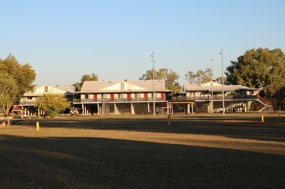
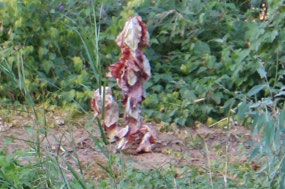
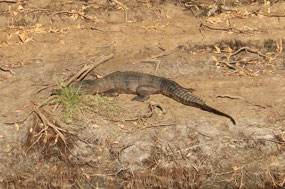
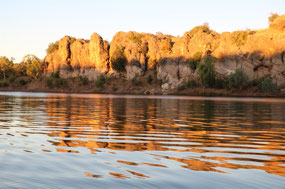
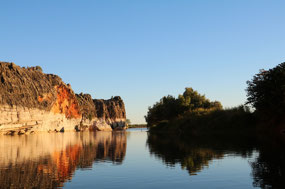
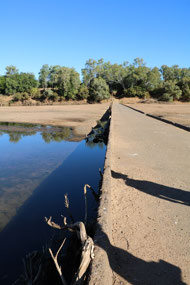
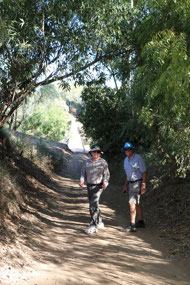
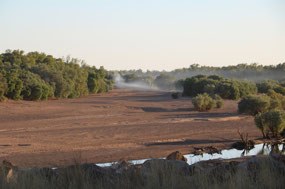
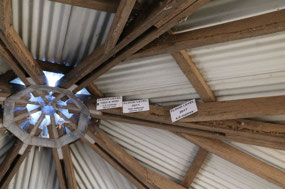
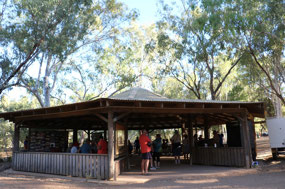
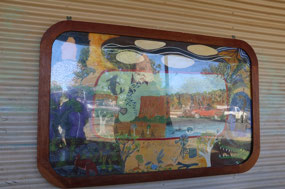
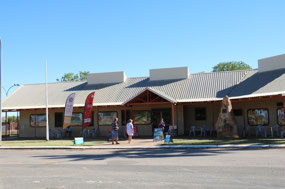

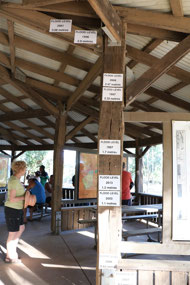

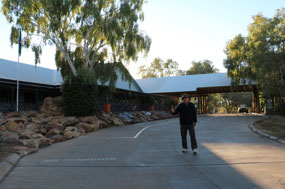
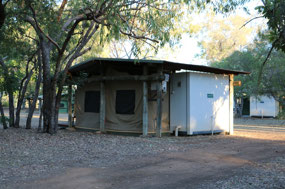
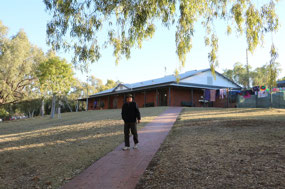
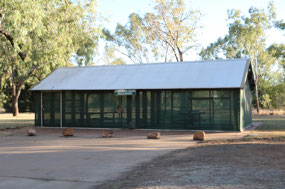
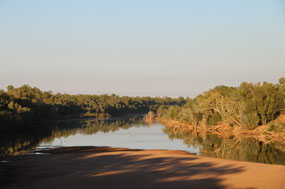
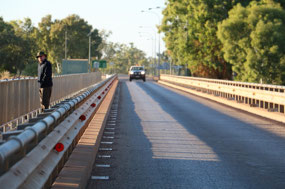
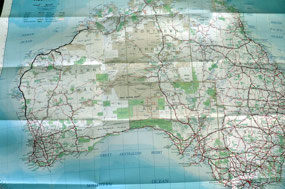
Jenny
2018-07-16
Geike Gorge's colours were just beautiful. Once again a highlight of our trip in 2015! Was it really that long ago? Maybe we'll get to do a Tag A Long trip again in the not too distant future. Although I'm happy to get lost on our own :-)
Julie
2018-07-17
Hard to believe that so much water gets down the Fitzroy River and the width of the river is amazing. Loved Geike Gorge too probably a must see for everyone, as the colours are something else. Didn't see that croc in the photos!